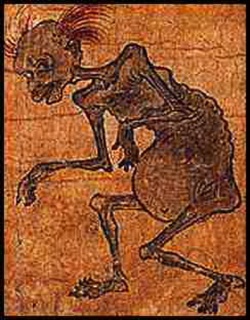Hungry Ghosts: their History and Origin
The Lord said: It is the men of sinful actions actuated by their previous misdeeds who become ghosts after death. Please listen to me, I shall tell you in detail (Garuda Purana, Vedas, verse 2.22.)
Hungry ghosts are the demon-like creatures described in Buddhist, Taoist, Hindu, Sikh, and Jain texts as the remnants of the dead who are afflicted with insatiable desire, hunger or thirst as a result of bad deeds or evil intent carried out in their life times. Found in every part of the Far East, from the Philippines to Japan and China, Thailand, Laos, Burma, India and Pakistan, they are universally described as human-like wraiths with mummified skin, narrow withered limbs, grossly bulging stomachs, long thin necks and tiny mouths.
Defined by a fusion of rage and desire, tormented by unfulfilled cravings and insatiably demanding impossible satisfactions, hungry ghosts are condemned to inhabit shadowy and dismal places in the realm of the living. Their specific hunger varies according to their past karma and the sins they are atoning for. Some can eat but find it impossible to find food or drink. Others may find food and drink, but have pinhole mouths and cannot swallow. For others, food bursts into flames or rots even as they devour it. Japanese hungry ghosts called gaki must eat excrement while those called jikininki are cursed to devour human corpses. According to Hindu tradition, hungry ghosts may endlessly seek particular objects, emotions or people, those things that obsessed them or caused them to commit bad deeds when they were living: riches, gems, children, even fear and the vitality of the living. A form of hungry ghost, called the Grigori, is found in Christian mythology. Mentioned in the Book of Enoch, the Grigori, and their offspring created by the union of Grigori and humans, wander the earth endlessly yearning for food though they have no mouths to eat or drink with. In China, hungry ghosts include the spirits of dead ancestors who are compelled to return to the earthly realm during the seventh month of the Chinese Lunar Calendar in August. These ghosts can eat human food, and offerings of cake, fruit and rice are commonly left out for them, while amulets are worn and incense is burnt to protect against those with evil intent or insatiable need.
For it is true that the desires of hungry ghosts are never satisfied and they must endlessly seek gratuity from the living. They can also cause misfortune to those whose chi energy is depleted or whose luck is bad. Some are driven seek to possess weak-willed men and women so as to dispossess their souls and take over their bodies, all the better to eat and drink with. In addition to hunger, hungry ghosts may suffer from immoderate heat and cold; the moon scorches them in summer, while the sun freezes them in winter, adding to their torment. The suffering of these creatures resembles that of the souls condemned to hell, but they are distinguishable by the fact that the damned are confined to the subterranean realm while hungry ghosts can occupy the world of the living.
In Buddhism, hungry ghosts are often seen as a metaphor for those individuals who are following a path of incorrect desire, who suffer from spiritual emptiness, who cannot see the impossibility of correcting what has already happened or who form an unnatural attachment to the past. Hungry ghosts are also sometimes used as a metaphor for drug addiction.
In the west, the time of hungry ghosts is tied subconsciously to the time of Halloween, when the spirits of loved ones may return to the realm of the living and be welcomed – or bring with them undesirable spirits replete with malicious intent. The candle placed in the jack o’ lantern or at the windowsill guides the souls of the beloved home, while the jack o lantern itself warns off the hungry ghosts.

